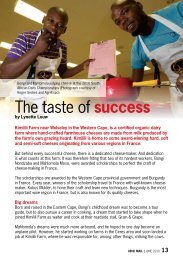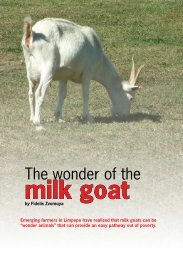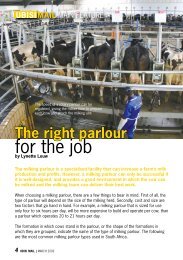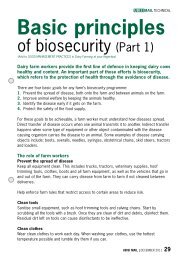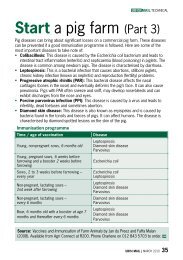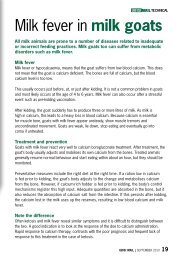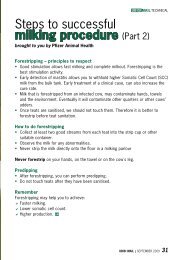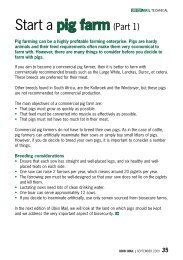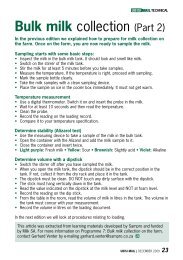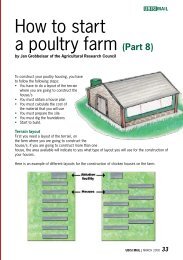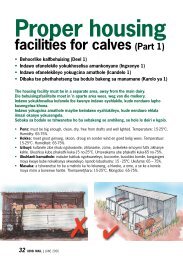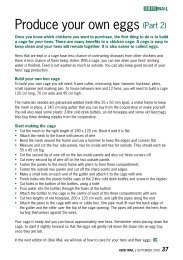Hygiene - Ubisi Mail Magazine
Hygiene - Ubisi Mail Magazine
Hygiene - Ubisi Mail Magazine
You also want an ePaper? Increase the reach of your titles
YUMPU automatically turns print PDFs into web optimized ePapers that Google loves.
<strong>Hygiene</strong><br />
in the milk parlour<br />
Sponsored by Ecolab<br />
Long ago we believed that we could clean milk by pouring milk through<br />
a strainer. Today we know better, but do we as workers understand the<br />
difference between clean and bacteriologically clean Do we realise that<br />
a tank that looks clean, is not really clean A milk strainer cannot stop<br />
bacteria or antibiotics.<br />
Bacteria<br />
Bacteria are very small organisms that one cannot see. They make food such as milk, meat<br />
and fish go bad very quickly and cause off tastes in cheese (dairy products). Bacteria need the<br />
following to grow properly:<br />
• Heat (temperature): bacteria love heat. That is why we have cold rooms, milk tanks and<br />
fridges.<br />
• Moisture: Bacteria are found in dust, but need moisture to grow.<br />
• Food: Milk, meat and fish are the ideal food. Bacteria in dirty milk tanks or milk machines<br />
have the heat, moisture and food they need to grow.<br />
Cleaning<br />
To effectively clean a milk tank and milk machine we need all three products:<br />
• Soap: Soap helps to remove the food (fat/protein) for bacteria from the system.<br />
• Acid: Acid is used to remove the lime that comes from the warm water for washing, from<br />
the equipment. The lime scale serves as a hiding place for milk remnants and bacteria.<br />
Acid also lowers the pH of the equipment and a low pH is bad for bacterial growth.<br />
• Sanitiser: After the soap removed all the food and the acid all the lime, there can still be<br />
bacteria in the milk machine. It is necessary to sanitise the equipment to kill the remaining<br />
bacteria.<br />
What does a good washing programme need<br />
Temperature: Fat and protein must be removed at a temperature of ±75ºC. If the water<br />
becomes cold, the fat and protein is left behind again. There is not such a thing as cold-water<br />
soap.<br />
20 UBISI MAIL | JUNE 2005
Concentration: The right amount of soap, acid and sanitiser must be used for the amount of<br />
water. Do not waste money by trying to save on the wrong things.<br />
Time: Every milk machine must be washed for a different length of time. The time must not<br />
be shorter than 6 minutes and not longer than 10 minutes. The temperature of the water for<br />
washing will determine the time for washing. The temperature of the water for washing must<br />
never be lower than body temperature. The milk tank is washed with a cleaning agent that<br />
foams to determine the time. The time that the foam takes to run down the sides of the tank,<br />
gives the soap the chance to work.<br />
Action: Action is achieved in the milk tank by using a tank brush. Action is achieved in the<br />
milk machine by letting in air at the suction pipe at the washbasin. The suction pipe must let<br />
in air for 3 seconds before the milk pump lets the water for washing run out in the washbasin.<br />
Longer than 3 seconds will cool down the water for washing too quickly.<br />
Washing programme for the milk machine<br />
Step 1 Rinse the milk machine with cold water. Lukewarm water is very dangerous as lukewarm<br />
does not feel the same for everyone. Water that is too hot will result<br />
in protein forming a layer in the equipment.<br />
Step 2 Wash the milk machine with warm (±75ºC) water and soap for<br />
between 6 and 10 minutes.<br />
Step 3 Rinse the milk machine with sanitiser in cold water ±3<br />
minutes.<br />
Step 4 Drain all water for washing from the equipment.<br />
Acid step Depending on the hardness (amount of lime) of the water,<br />
the milk machine must be washed with an acid once or twice a<br />
week. It can be cold water for 10 minutes. The acid step is done after<br />
Step 2 and before Step 3.<br />
Washing programme for the milk tank<br />
Step 1 Rinse the last milk out of the tank with cold running water (use a hose-pipe).<br />
Step 2 Mix a solution of ±15 litres warm water (75ºC) and foaming soap in a<br />
plastic bucket. Place the bucket in the tank and wash the milk tank with a<br />
brush from top to bottom. Use a bucket because it helps to maintain<br />
the temperature of the water. Do not forget to wash the tank outlet<br />
and gauge/yardstick.<br />
Step 3 Sanitise the milk tank by applying the sanitiser with a spray<br />
bottle or by washing the tank with a tank brush.<br />
Step 4 Drain the sanitising water.<br />
Acid step The milk tank must be washed with a strong acid once a week<br />
to remove lime scale. This step is done after Step 2 and before Step 3.<br />
IMPORTANT: Never rinse<br />
the milk machine again<br />
with clean water after it<br />
was sanitised.<br />
IMPORTANT: Never the<br />
rinse the milk tank with<br />
clean water after it was<br />
sanitised.<br />
UBISI MAIL | APRIL 2005 21
22 UBISI MAIL | JUNE 2005
Safety<br />
Cleaning agents are very dangerous and must be handled with care. You cannot replace your<br />
eyes.<br />
• Containers must always be clearly marked (use labels).<br />
• Containers must always be closed and stored high or behind a locked door.<br />
• Soap that is poured into a jug must be poured into the water for washing immediately and<br />
must never be allowed to stand unused.<br />
• The jug used for scooping out the soap must be rinsed after it was used.<br />
• Empty soap containers must be rinsed<br />
before it is stored or used for water for<br />
workers.<br />
Treatment<br />
Accidents happen and therefore treatment on<br />
the farm is very important. Quick action can<br />
save your eyes, throat or stomach.<br />
Skin: If the skin gets in contact with soap or<br />
acid, wash it thoroughly. If the skin is broken,<br />
visit your doctor.<br />
Eyes: If you get soap or acid in your eyes,<br />
rinse it with as much water as possible and<br />
visit a doctor.<br />
Mouth: If you drink acid, drink as much water<br />
or milk to dilute the acid. Put your finger down<br />
your throat to help you throw up. If you drink<br />
soap (soda), drink lots of water or milk. Do not<br />
throw up. Visit your doctor.<br />
Cost calculation<br />
We often hear people say soap is soap, but that is not at all true. We no longer read the labels.<br />
We compare the prices. Here is a quick calculation that every dairy farmer can make:<br />
How much water for washing is used, eg 60 litres<br />
How much lime is in the water<br />
“Long ago we believed<br />
How much cleaning agent per litre of water for washing is needed according to the label, eg<br />
5 ml/litre<br />
Price of the cleaning agent per ml, eg R264 divided by 25 000 ml = 1,056c<br />
Cost per wash<br />
60 litre x 5 ml = 300 ml<br />
300 ml x 1,056 (price) = R3,16 UM<br />
that we could clean<br />
milk by pouring milk<br />
through a strainer.<br />
Today we know better,<br />
but do we as workers<br />
understand the difference<br />
between clean and<br />
bacteriologically<br />
clean”<br />
UBISI MAIL | APRIL 2005 23



